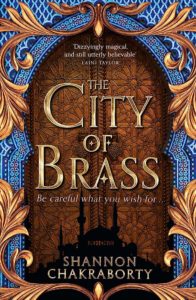S.A. Chakraborty spends the first fifty or so pages of The City of Brass creating an alternative fantasy Cairo that’s so multifaceted, so lively, so enthralling and exciting that I never really reconciled to the characters’ departure. Sure, Daevabad is the fabled City of Brass. It’s full of djinn in all of their different clans; it’s practically pulsing with magic; it’s monumental and gorgeous. But give me Cairo’s alleys and markets where Nahri plies her various trades of thieving and deceiving. Give me all the peoples that the Nile, history, and Cairo’s fabulous wealth have brought together. Give me her Jewish apothecary friend and teacher, though they exasperate each other. Give me gullible Turks, Nubian ceremonies, Franks as unseen rulers of the city whose authority clearly does not extend to much of the streets.
Nahri is a young woman of uncertain background — though she says “I am as Egyptian as the Nile” (p. 6) to a Turkish basha she is setting up for a burglary — who is making her way by her wits, healing talents, and convincing impressions of being a medium. She steals, of course, but it’s in the best traditions of the protagonist of a fantasy story. She does it with style and élan, mostly from people who can well afford it, and she aids people less fortunate than even her precarious self.
Until one day when she accidentally calls forth a real djinn mere hours after she said to her apothecary friend “There’s no magic, no djinn, no spirits waiting to eat us up.” (p. 27) By the time she regrets her words, she’s caught between a djinn, an ifrit, and grabbed by ghouls springing up from Cairo’s largest burial grounds. To say nothing of the flying carpet.
At that point, Chakraborty introduces the other protagonist of The City of Brass: Ali, a prince of the ruling family of Daevabad. He is a pious young man who has grown up in military training, almost exclusively in the company of other boys and men. He can be a prig and a hard-liner, but he also wants to help the downtrodden of his father’s realm, and he is aware of some of the injustices of his family’s rule. He’s unaware of his own naiveté, and he is surrounded by unscrupulous people in his family, his father’s court, and the people he thinks he’s helping.
On one level, The City of Brass is a story of Nahri beginning to discover who she is, and Ali beginning to discover who he could be. For Nahri, questions abound: why doesn’t she have any family? How can she understand any language? What does it mean that she can sometimes heal people? Ali has different questions: how can he reconcile his beliefs and his role? Can he help change his city without bringing greater suffering? Will he live long enough to have a chance to do either? And then there’s Dara, the djinn Nahri has inadvertently called back into the world. Chakraborty does not tell chapters from his point of view because one of the central mysteries of the book is who, what, he really is. How much of what he tells Nahri is true?
On another level, the book is a story of intrigues and power struggles among the factions of djinn in Daevabad. The city itself is located among the mountains that form the southern borders of Central Asia, maybe near Samarkand’s location, separated from the human world by a veil of magic. Its ruling family comes from the books analog of Arabia and practices a strict and ascetic form of Islam, though in the tradition of royal families the world over, many of them ignore the precepts that they proclaim for others. Other clans remember when they held more power and would not be unhappy to see the wheel turn again.
All the while, The City of Brass remains an adventure tale, with the characters getting in and out of scrapes, facing reversals, uncovering betrayals and finding unexpected allies — whose help may come at a price. Though I never really got over leaving Cairo, I did eventually warm to Daevabad. I did have a hard time getting through the roughly 150 pages of the desert journey to the city of the djinn, which I solved by reading a dozen or so other books in the meantime without ever definitively setting The City of Brass aside. I’m glad I stuck it out because once Nahri and Dara make it into the city, the story picks up and gets to rollicking. Once it does, the book’s levels support each other to build a solid resolution that’s nevertheless the opening for the rest of Chakraborty’s trilogy.
+++
Doreen’s review of The City of Brass is here.
The author now publishes as Shannon Chakraborty, as the cover of the current edition of The City of Brass shows. There’s probably a lot to unpack there.

